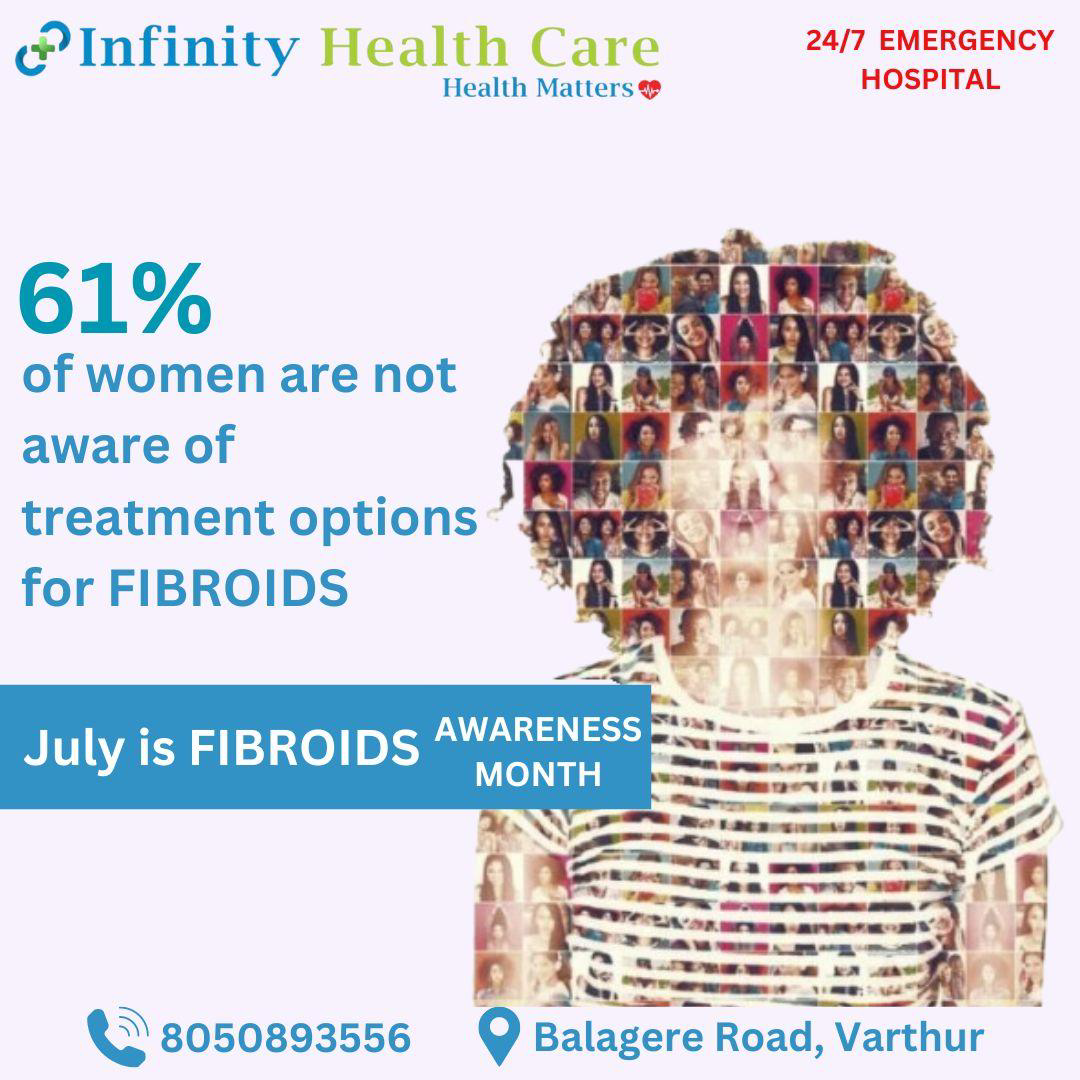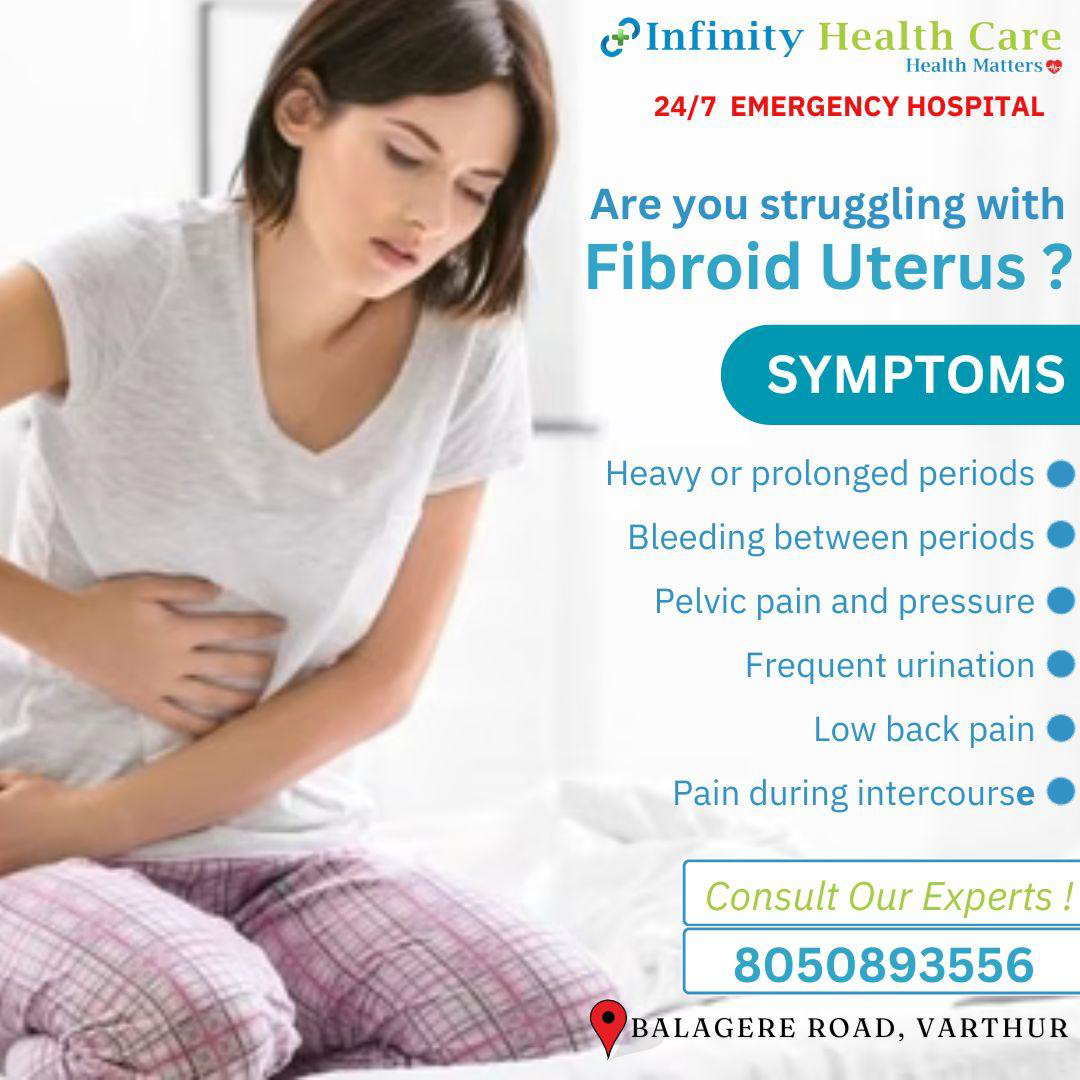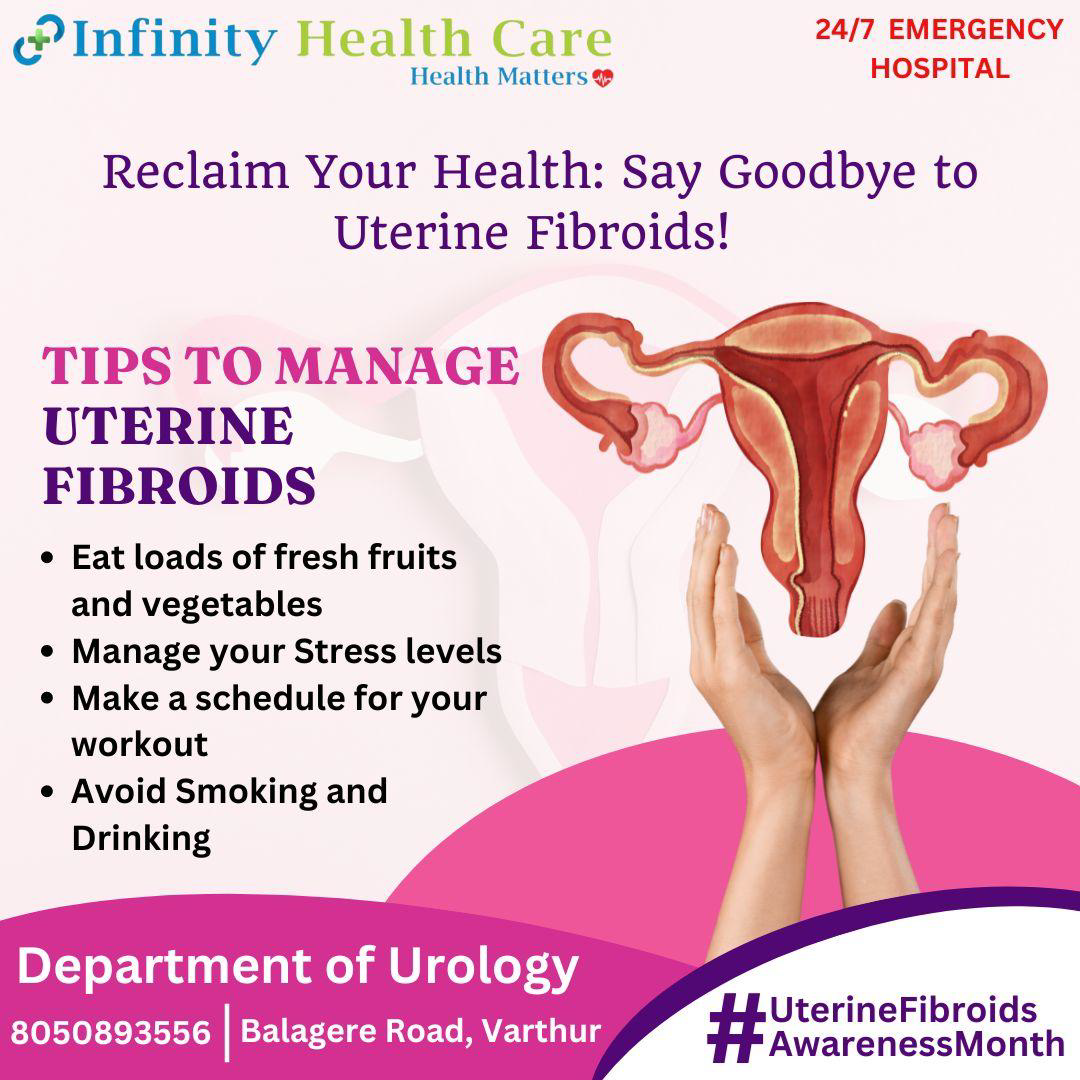Uterine fibroids are prevalent noncancerous tumors that can develop within or on the uterus. Although not all fibroids produce symptoms, they can cause issues such as heavy menstrual bleeding, back pain, frequent urination, and discomfort during intercourse. Smaller fibroids might not require intervention, while larger ones may necessitate medication or surgical procedures.
July is recognized as International Uterine Fibroid Awareness Month, an opportunity to raise awareness about this condition that impacts many women worldwide. At Infinity Health Care, especially within our Gynecology Department, we are committed to offering exceptional care and information to the community in Balagere, Bangalore.
Uterine fibroids, medically referred to as leiomyomas, are non-malignant tumors consisting of muscle and connective tissue that form on or within the walls of the uterus. These growths are the most frequently occurring benign tumors in women. Although many fibroids do not cause any symptoms, some can lead to discomfort, pain, and heavy or irregular menstrual bleeding. The approach to treating fibroids depends on the specific symptoms experienced.

Fibroids, also known as uterine leiomyomas or myomas, can grow in different locations within or on the uterus. They can vary greatly in size, from as small as a seed to as large as a watermelon. The main locations where fibroids can develop are:
Intramural Fibroids: These grow within the muscular wall of the uterus and are the most common type.
Submucosal Fibroids: These develop just underneath the lining of the uterine cavity. They can protrude into the uterine cavity and are less common but can cause severe symptoms.
Subserosal Fibroids: These grow on the outer surface of the uterus, projecting outward. They can sometimes become very large and press against other organs.
Pedunculated Fibroids: These are attached to the uterus by a thin stalk and can develop either inside the uterine cavity (pedunculated submucosal fibroid) or outside the uterus (pedunculated subserosal fibroid).
Fibroids can grow as a single growth or in clusters, and their size can range from very small (1 millimeter) to very large (over 20 centimeters in diameter).
Yes, fibroids are quite common. Approximately 40% to 80% of people with a uterus will develop fibroids at some point in their lives. These non-cancerous growths occur most frequently in people aged 30 to 50. Typically, individuals who haven't had their first period (menarche) do not have fibroids, and the occurrence of fibroids tends to decrease in people who have entered menopause.
Fibroids, also known as uterine leiomyomas, can cause a range of symptoms depending on their size, location, and number. While small fibroids may remain asymptomatic, larger ones can lead to various issues, including:
The exact cause of fibroids is not well understood, but several factors are believed to play a role:
The symptoms of uterine fibroids often stabilize or diminish after menopause because the body's hormone levels, particularly estrogen and progesterone, decrease significantly.
Uterine fibroid pain can manifest in various ways, depending on the size, number, and location of the fibroids. Here's a detailed look at the types of pain and discomfort that can occur:
The intensity and nature of the pain can vary widely from person to person. If you experience significant pain or other symptoms, it's important to consult with a healthcare provider for an accurate diagnosis and appropriate management.

Fibroids are indeed characterized by their rounded shape and can vary in size from as small as a pea to as large as a grapefruit. They are usually firm, smooth to the touch, and can sometimes have a whitish or pinkish coloration. Their appearance can resemble that of a small ball or lump embedded in the uterine wall.
The specific cause of uterine fibroids remains unclear, although medical experts suggest that hormones such as estrogen and progesterone are significant factors. These growths commonly occur in individuals of reproductive age. Research indicates that fibroids tend to enlarge in response to elevated hormone levels, such as during pregnancy, and may decrease in size when hormone levels decline, such as during menopausal transition.
Risk Factors Numerous factors can heighten the likelihood of developing fibroids, such as:
Fibroids have the potential to induce anemia. Anemia arises when the body lacks sufficient healthy red blood cells to transport oxygen to organs. This condition can affect individuals who experience frequent or excessively heavy menstrual periods. Fibroids often contribute to increased menstrual bleeding or intermittent bleeding episodes. If you notice symptoms of anemia alongside fibroids, it's advisable to consult your healthcare provider promptly.
Although the majority of fibroids do not result in severe complications, they can give rise to significant problems such as pain, excessive bleeding, and, in rare instances, infertility. Additionally, they may contribute to anemia owing to the heavy flow during menstruation.
At Infinity Health Care in Balagere, Bangalore, our Gynecology Department provides comprehensive diagnostic services for uterine fibroids. Typically, healthcare providers detect uterine fibroids during routine pelvic exams, especially when patients present with symptoms such as heavy bleeding. To confirm the presence, size, and location of fibroids, several diagnostic tests are available:

Treatment options for uterine fibroids can vary based on factors such as the size, number, and location of the fibroids, as well as the symptoms they cause. If you do not experience symptoms, treatment may not be necessary, and small fibroids can often be monitored without intervention. Some individuals with fibroids may never develop symptoms or encounter complications. In such cases, healthcare providers might suggest regular monitoring through pelvic exams or ultrasounds.
However, if you do experience symptoms like anemia due to heavy bleeding, significant pain, or issues with urinary or bowel function, treatment becomes necessary. The approach to treatment will be tailored based on several factors:
The best treatment option for you will also depend on your plans for pregnancy in the future. Talk to your healthcare provider about your fertility goals when discussing treatment options. Treatment options for uterine fibroids can include:
It's crucial to discuss any medications with your healthcare provider. Always seek their advice before starting a new medication to understand potential risks and benefits.
When discussing the various surgical options for removing fibroids, several factors come into play. These include the size, location, and number of fibroids, as well as your future pregnancy desires, which are crucial in devising a treatment plan. Certain surgical approaches aim to preserve fertility, while others may involve the removal or potential damage to the uterus. Myomectomy is a procedure designed to remove fibroids, with several types available depending on individual circumstances. These types include:
Each type of myomectomy is chosen based on factors such as fibroid location, size, and number, tailored to meet the patient's specific medical needs and fertility considerations. If you're not considering future pregnancies, your healthcare provider may suggest additional treatment options that can effectively manage uterine fibroids without preserving fertility:
Each of these options provides distinct benefits and considerations based on individual health needs and preferences. Consulting with your healthcare provider can help determine the most appropriate treatment plan for you.
All treatments carry potential risks. Medications can cause side effects, and not all may be suitable for every individual. It's crucial to disclose all current medications and your complete medical history to your healthcare provider before starting any new treatment. If you encounter side effects from a new medication, promptly contact your provider to explore alternative options.
Surgical interventions for fibroids also pose risks. Any surgical procedure carries risks of infection, bleeding, and complications related to anesthesia. Specifically, procedures to remove fibroids may impact future pregnancies, as some options could affect fertility. A myomectomy, which selectively removes fibroids while preserving the uterus, allows for potential future pregnancies but may necessitate delivery via cesarean section in subsequent pregnancies.
There is no specific size threshold for fibroids that automatically mandates their removal. The decision to undergo surgery depends on individual symptoms and their impact on your health. For instance, even small fibroids can cause significant bleeding depending on where they are located. Your healthcare provider will assess your symptoms and discuss whether surgical intervention is necessary.
If you don’t have symptoms, treatment for fibroids may not be necessary. If you have large fibroids or your symptoms are causing you pain and discomfort, getting treatment may be the best option. Only you and your provider can decide the best course of treatment or if treatment is necessary.
Fibroids generally cannot be completely prevented. However, you can lower your risk by maintaining a healthy weight and scheduling regular pelvic exams. If small fibroids are detected, working closely with your healthcare provider to establish a monitoring plan is advisable.
Yes, it is possible to conceive if you have uterine fibroids. If you are aware of your fibroids prior to becoming pregnant, your healthcare provider will collaborate with you to establish a monitoring strategy for them. During pregnancy, your body experiences heightened hormone levels that support the pregnancy but may also contribute to fibroid growth. Larger fibroids can pose several challenges during pregnancy, including:
Fibroids have the ability to fluctuate in size over time, either increasing or decreasing gradually. These changes are typically influenced by hormonal fluctuations within the body. Elevated hormone levels, such as during pregnancy, can cause fibroids to enlarge. Conversely, a decrease in hormone levels, particularly after menopause, often leads to shrinkage of fibroids. It's common for symptoms associated with fibroids to improve following menopause as well.
Fibroids have the potential to decrease in size post-menopause due to reduced hormone levels. This natural shrinkage can alleviate associated symptoms. If small fibroids are asymptomatic, they may not require any treatment.
Feeling tired isn’t a common symptom of uterine fibroids. However, it’s a common symptom of anemia, which can occur when you lose too much blood. Talk to a healthcare provider if you feel excessively tired so they can determine the cause.
Yes, it’s possible that large uterine fibroids can cause your stomach to bloat or appear larger.
Contact your healthcare provider if you have symptoms of uterine fibroids, such as:
Because these symptoms are common symptoms of other gynecological conditions, discussing them with a healthcare provider is important.
Infinity Health Care is committed to female health and provides expert care for those struggling with uterine fibroids. Our team of specialists in the Gynecology Department ensures personalized and compassionate care for every patient. Regular checkups at Infinity Health Care can help monitor and manage fibroids effectively, ensuring a better quality of life.
If you’re experiencing symptoms or have concerns about uterine fibroids, consult our expert team at Infinity Health Care on Balagere Road, Varthur, Bangalore. Our dedicated professionals are here to provide the best treatment and care for your health needs.
To reach us please contact on Phone No.8050893556, Balagere Road,Varthur, Email – contactinfinityhealthcare@gmail.com and Website - www.infinityhealthcare.co.in
Written By
Infinity Health Care